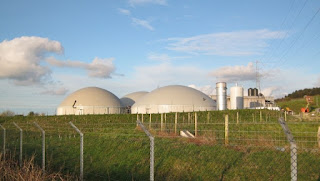Various Factors Affecting the Production of Biogas
The rate of production of biogas depends on the following factors :
- Temperature and pressure
- Solid concentration and loading rate
- Retention period
- pH value
- Nutrients composition
- Toxic substances
- Digester size and shape
- Stirring agitation of the content of digester.
1. Temperature and pressure :
- The process of anaerobic fermentation and methane forming bacteria works best in the temperature range of 25°C-55°C and pressure of about (1.1-1.2) bar absolute. The rate of gas production increases with the increase in temperature but the percentage of methane reduces.
- It is found that temperatures 35°C-38°C are best for methane production. If the temperatures are lower than 20°C (as in case of cold countries and in winters) the rate of gas production falls sharply and it almost ceases at about 10°C.
- Thus, in cold climates, it is necessary to heat the digester to about 35°C.
2. Solid concentration and loading rate :
- The cow dung, water and various organic residues from agricultural waste are supplied as feed to the digester. The proportions recommended are : b Cow dung+solid waste 1 : 1 by weight and forming to about 10% of solid content and 90% of water.
- The amount of feed supply per day to the digester is called loading rate. It is dependent on the size of the plant.
- The recommended loading rate is about 0.2 kg/m3 of digester capacity. The underloading and overloading reduces the biogas production.
- The loading of feed must be carried out every day at the same time so as to keep the solid concentration ratio constant in the digester.
3. Retention period :
- It represents the time period for which the fermentable material remains inside the digester. This period ranges from 35 days to 50 days depending upon the climatic conditions and location of the digester.
- The longer retention period needs larger size digester and it allows more complete digestion of feed.
4. pH value or Hydrogen ion concentration :
- pH value indicates the degree of acidity or alkalinity of a solution. The pH value is represented as the logarithm of the reciprocal of hydrogen ion concentration in gm equivalent per litre of solution.
- pH value in the range 0-7 represents acidic solution and in the range 7-14 indicates the alkaline solution. In the initial stages of acid forming stage of digestion, the pH value may be around 6 or less, however during methane formation stage the pH value higher than 7 is maintained since methane formers are sensitive to acidity.
- For above reasons the optimum pH value of digester solution between 7 to 8 is recommended for biogas formation.
5. Nutrients concentration :
- The major nutrients required by the bacteria in the digester are N2, P, S, C, H2, O2 to accelerate the anaerobic digestion rate. Thus it is necessary that the major nutrients are supplied in correct chemical form and concentrations.
- The carbon in carbohydrates supplies the energy and the nitrogen in proteins is needed for building of growth of bacteria. C : N ratio need to be supplied in the ratio of 30 : 1 with 2% phosphorous for maximum biological activity. Thus, for acceleration fermentation and production of biogas nutrients like C, P, N2 are are needed.. Oil cakes and animal urine are found to be suitable nutrients for this purpose.
6. Toxic substances :
- The presence of ammonia, pesticides, detergents, heavy metals are considered as toxic substance to micro-organisms since their presence reduces the fermentation rate. Also the digested slurry if allowed to remain in digester beyond certain time, it becomes toxic to micro-organism growth.
7. Digester size and shape :
- It is found that the biogas production per unit volume of digester is high when its diameter to depth ratio ranges between 0.66 to 1.
8. Stirring or agitation of the content of digester :
- Since bacteria in the digester has very limited reach to their food, it is necessary that the slurry is properly mixed and bacteria get their food supply.
- It is found that occasional mixing allows the masses that float at the top in the form of scum allows to mix with the deposits at the bottom. It helps in improving the fermentation process.

